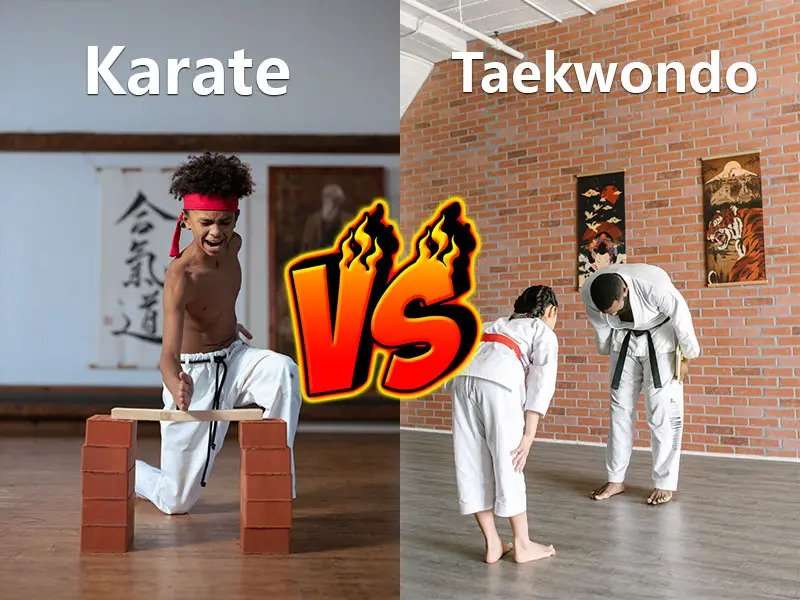difference between taekwondo and karate
Description
Taekwondo vs. Karate: Understanding the Key Differences
Martial arts have attracted the human spirit for centuries, offering a path to self-discipline, physical skills, and personal growth. Within this rich hanging of combat disciplines, two stand out famously: Taekwondo and Karate. These martial arts have garnered immense popularity worldwide, drawing in practitioners with unique philosophies, techniques, and histories. To enter a journey into martial arts, one must first embrace the key differences that set Taekwondo and Karate apart.
This exploration will expand your appreciation for these respectable practices and help you make an informed choice if you're considering taking up martial arts as a means of self-improvement or self-defense. In this blog, we will explore the heart of Taekwondo and Karate and disclose the historical origins, underlying philosophies, distinct techniques, training methodologies, and much more that make these martial arts extraordinary.
Historical Background
1. Taekwondo
Taekwondo originated in Korea and is deeply rooted in the country's history. It draws influence from traditional Korean martial arts and different Chinese martial arts forms. Historically, Taekwondo has been influenced by centuries of dispute on the Korean Peninsula, leading to its importance in self-defense and combat techniques.
2. Karate
Karate, on the other hand, finds its origins in Okinawa, Japan, but it owes much of its martial art heritage to Chinese martial arts. Karate was developed as a means of unarmed self-defense in a region where weapons were often forbidden. The combination of Okinawan fighting styles with Chinese martial arts principles marks its history.
Philosophy and Principles
1. Taekwondo
Taekwondo places a vital importance on high, fast kicks and agile footwork. Its philosophy centers on the idea that the legs are the most potent and extended part of the body, and thus, they should be used to the fullest. Speed, flexibility, and precision are the fundamental principles of Taekwondo.
2. Karate
Karate, in comparison, prioritizes powerful strikes using the hands and feet. It focuses on solid stances, rights techniques, and efficient body movement. The philosophy of Karate centers around discipline, control, and the development of a strong character through proper training.
Techniques and Movements
1. Taekwondo
Taekwondo practitioners are known for their impressive spinning kicks, jumping kicks, and quick footwork. It's common to see breathtaking aerial movements and high kicks aimed at head-level targets.
2. Karate
Karate techniques include numerous punches, kicks, blocks, and stances. While they may not involve as much aerial acrobatics as Taekwondo, Karate strikes are distinguished by their focus on accuracy, power, and control.
Training and Sparring
1. Taekwondo
Taekwondo training often includes board breaking to demonstrate the power of kicks, Olympic-style sparring, where points are awarded for strikes to specific target areas, and practicing forms (known as poomsae). Safety gear like headgear, gloves, and shin guards are commonly used in sparring.
2. Karate
Karate training programs often involve kata practice (a prearranged series of movements), bunkai (applications of kata), and kumite (sparring). Karate's sparring rules and safety gear may change depending on the style, but they generally prioritize control and technique.
Scoring and Competitions
1. Taekwondo
In Taekwondo competitions, points are awarded for successful kicks and strikes to specific target areas, with headshots earning the most points. The World Taekwondo Federation (WT) and the International Taekwon-Do Federation (ITF) are two major governing bodies supervising competitions.
2. Karate
Karate competitions typically score techniques based on accuracy, power, and control. There are different styles of Karate, each with its own rules and scoring systems. The World Karate Federation (WKF) is one of the leading organizations regulating Karate tournaments.
Belts and Ranking Systems
1. Taekwondo
Taekwondo uses a colorful belt ranking system to indicate a practitioner's rank, with each color representing a different skill level. Different intermediate colors mark the journey from a beginner's white to a black belt.
2. Karate
Karate employs a more straightforward and more traditional black belt ranking system. In Karate, the black belt symbolizes advanced skills and mastery of the art. The Dan and Kyu ranks symbolize a practitioner's experience and skill level.
Self-Defense and Real-world Application
1. Taekwondo
With their attention on high kicks and agility, Taekwondo techniques may need to be more suited for practical self-defense in close-quarters situations. However, Taekwondo practitioners can adjust their skills for real-world scenarios by incorporating hand strikes and grappling techniques.
2. Karate
Karate's focus on robust and efficient strikes makes it applicable for self-defense. Its techniques, designed for close-quarters combat, can readily be applied in real-life situations. Karate practitioners often train to defend against different types of attacks.
Popularity and Global Reach
Taekwondo and Karate have achieved significant global popularity:
Both Taekwondo and Karate enjoy worldwide popularity, with innumerable practitioners and schools in many countries. Taekwondo's inclusion in the Olympics has raised its global recognition, while Karate has a multiple range of styles and practitioners.
Notable practitioners and champions from both martial arts have further contributed to their popularity on the world stage.
Conclusion
In martial arts, Taekwondo and Karate are definite and celebrated disciplines, each with its unique history, philosophy, techniques, and training methods. Understanding the critical differences between these martial arts is crucial for prospective practitioners. Ultimately, the choice between Taekwondo and Karate should be regulated by your personal goals, whether self-defense, competition, or personal development. Regardless of your choice, Taekwondo and Karate deserve our respect and appreciation for their profound contributions to the martial arts world.






















